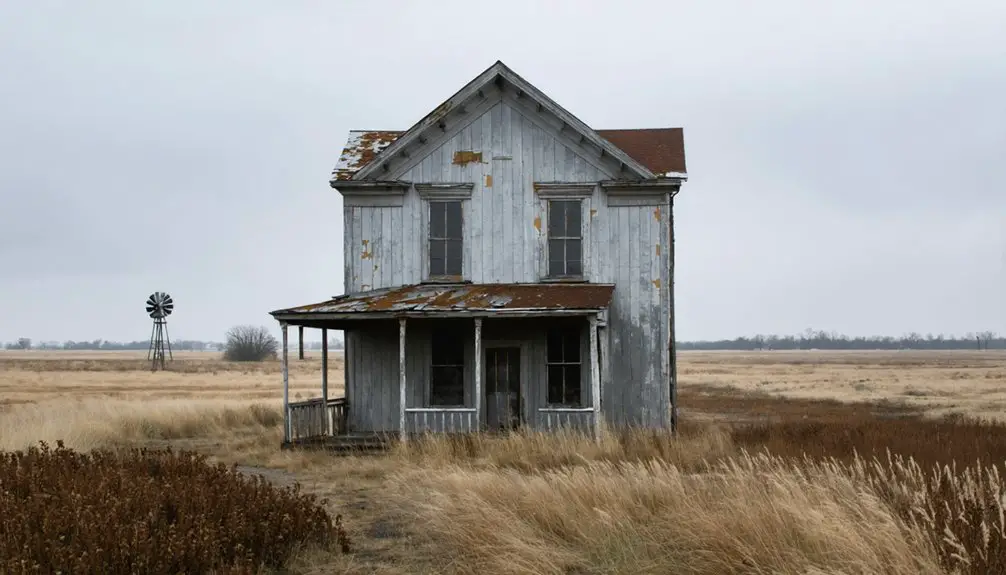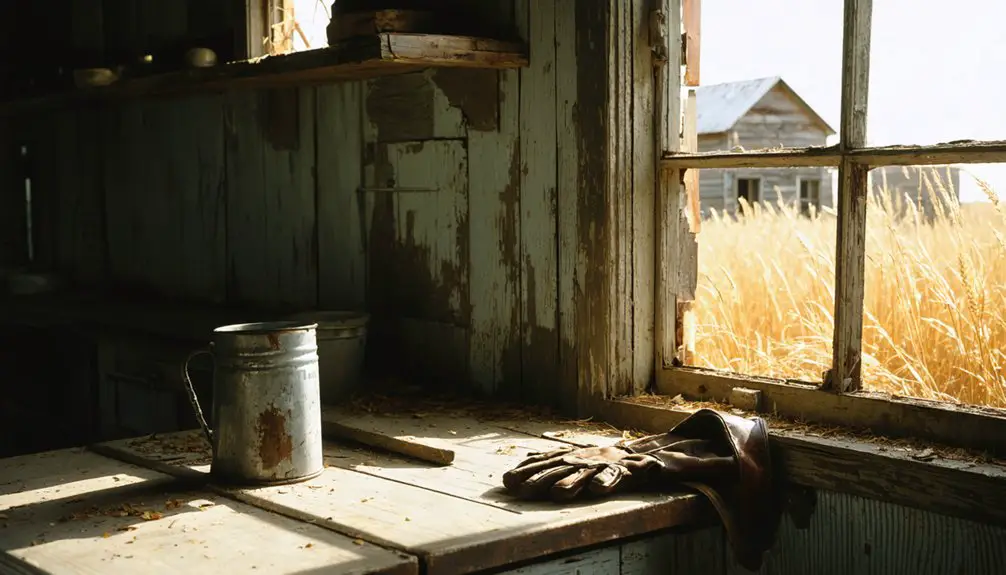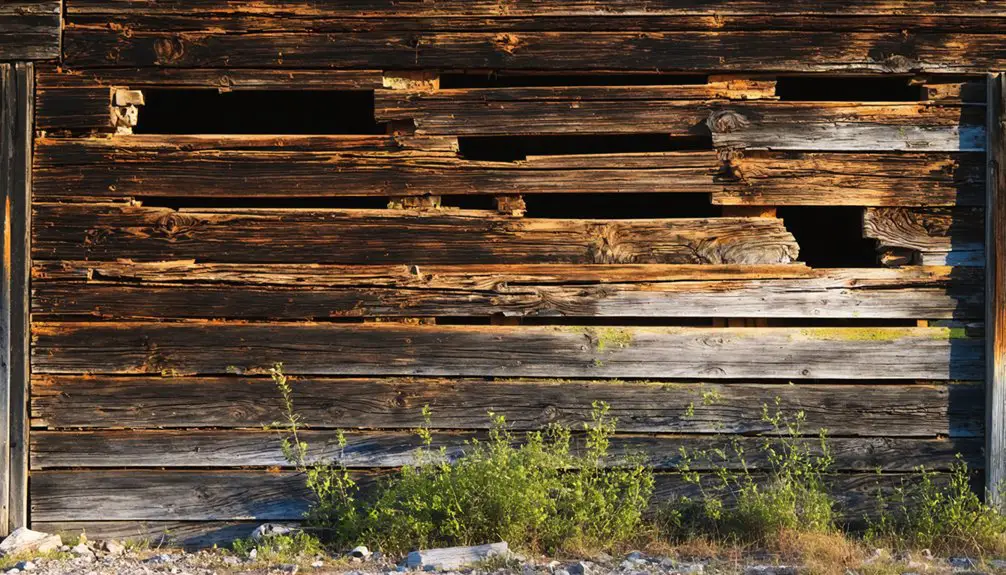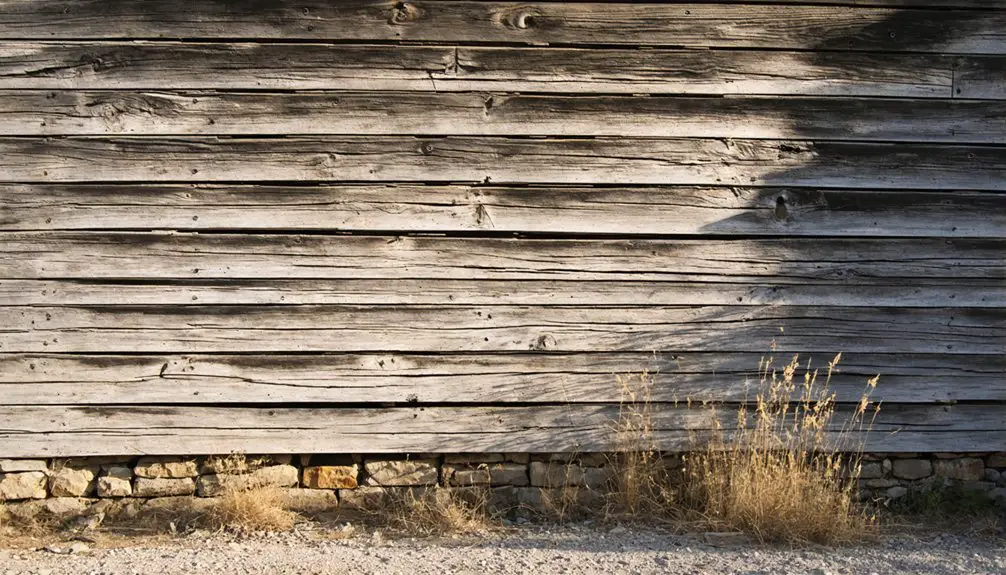You’ll find Oak Wall’s remnants in eastern Cimarron County, Oklahoma, where it once thrived as a mining and agricultural hub. The town emerged during territorial expansion and reached its peak in the 1920s with several hundred residents. Its economy centered on lead and zinc mining, which supplied over half of America’s needs during WWI. Today, only scattered foundations and deteriorating structures mark where this prosperous community once stood, each crumbling wall holding untold stories of the past.
Key Takeaways
- Oak Wall was a prosperous mining town in Oklahoma’s Panhandle region that produced over $20 billion in lead and zinc ore between 1917-1947.
- The town’s peak population occurred in the 1920s, supported by mining operations, agricultural trade, and railroad commerce.
- Economic decline began when timber resources depleted and the Santa Fe Railroad rerouted away from Oak Wall in 1912.
- The ghost town is located 7 miles SSW of Oaks, Oklahoma, with only scattered foundations and deteriorating buildings remaining.
- The site has no visitor facilities or markers, and natural hazards include unstable ground, hidden wells, and local wildlife.
Historical Origins and Settlement
Though Oak Wall’s exact founding date remains unclear, the town emerged during a period of rapid territorial expansion when economic opportunities drew settlers to establish new communities.
Like many Oklahoma towns of the era, Oak Wall likely served as a liquor town catering to residents from neighboring dry territories.
Like many founding myths of Oklahoma Territory, Oak Wall’s settlement patterns reflected the era’s pioneering spirit, with early residents likely drawn by promises of agricultural prospects or potential railroad connections.
You’ll find that Oak Wall’s establishment followed typical development trends of the time, serving as a supply depot and trading post for nearby farming communities.
The town’s name, while its origin isn’t certain, probably honored either a prominent local figure or a geographic feature – a common naming practice in territorial settlements.
Like countless frontier towns, Oak Wall likely drew its distinctive name from local geography or an early settler’s legacy.
Early prosperity centered on providing services to transient populations, including cowboys and travelers, with saloons and merchants establishing the town’s initial economic foundation.
Similar to the rivalry between Eschiti and Kell City, Oak Wall faced intense town promoter competition that shaped its early development.
Geographic Location and Terrain
Located in the eastern part of Cimarron County near the Texas County border, Oak Wall sits within Oklahoma’s westernmost Panhandle region.
You’ll find the ghost town amid flat to gently rolling plains, where geological features reflect the typical High Plains landscape. Similar to how lead and zinc mining transformed Picher into a toxic wasteland, the area’s semi-arid climate receives only 15-18 inches of annual rainfall, shaping the terrain’s sparse vegetation of prairie grasses and low shrubs.
The site’s sandy loam soil has supported agricultural practices through the decades, though you’ll notice how modern farming and ranching operations have overtaken many former town structures.
While the land once accommodated railroad construction, you won’t find many natural shelters or water sources nearby. The surrounding fields and grazing lands demonstrate how the region’s environmental conditions have influenced its shift to primarily agricultural use. Like many towns in the area during the drought and depression years, Oak Wall’s population gradually declined as residents sought better opportunities elsewhere.
Peak Population and Economic Activities
During its height in the 1920s, Oak Wall’s population likely reached several hundred residents, mirroring the size of comparable Oklahoma railroad towns from that era.
The town served as a crucial trading hub for the surrounding rural community, featuring essential businesses like general stores, grain elevators, and agricultural supply merchants. Like many communities that experienced a similar fate, Oak Wall left behind crumbling buildings that serve as reminders of its former prosperity. The low-lying terrain made the area prone to frequent flooding, similar to the challenges faced by other Oklahoma settlements.
You’ll find that Oak Wall’s economy centered around agricultural trade and railroad commerce, with local farmers bringing their crops to town for storage and shipping.
Population Height During 1920s
As Oklahoma’s oil boom swept through the region in the 1920s, Oak Wall’s population swelled to several hundred residents, primarily consisting of oil workers and their families. The region’s industrial growth mirrored towns like Picher where mining operations boomed.
Population estimates suggest the town reached between 200 to 500 people at its peak, though exact numbers weren’t consistently tracked. You’d have found a bustling community of transient workers moving in and out of town, following the ebb and flow of oil production.
The town’s demographics shifted constantly as workers chased promising drill sites. Most residents lived in basic company housing or hastily built structures, creating a temporary but vibrant community. Similar to the zinc smelting operations in Kusa, the town’s economy relied heavily on natural resource extraction.
While families put down short-term roots, establishing schools and churches, the population remained highly mobile, ready to relocate whenever oil prospects dimmed.
Mining and Railroad Impact
When lead and zinc deposits were discovered on Harry Crawfish’s land in 1913, Oak Wall’s economic landscape transformed dramatically. You’d have seen over 14,000 miners working the rich deposits that yielded more than $20 billion in ore value between 1917 and 1947. The mining legacy dominated national production, supplying over half of America’s lead and zinc needs during WWI. Child laborers as young as twelve worked alongside adult miners in the dangerous underground operations.
To avoid confusion with other mining towns named Oak Wall, the area was often referred to as Oklahoma Oak Wall. The railroad influence was equally transformative, with an extensive rail network connecting Oak Wall to Carthage, Missouri. You’d have found nearly 1,500 mining service businesses thriving alongside the tracks, from equipment repair shops to supply outlets.
The railroad’s reach enabled efficient ore transport to national markets while supporting a diverse economy of ancillary industries that served both the mines and their workers.
Local Trading Hub Details
The bustling economic hub of Oak Wall extended far beyond its mining operations, supporting a diverse network of commerce and trade. You’d find the town’s trading strategies centered around agricultural supply chains, with merchants adapting to shifting market dynamics through seasonal auctions and market days.
While exact population figures aren’t documented, the town likely housed between 500 to 5,000 residents during its peak, comparable to other regional centers.
Key economic drivers included:
- General stores and mercantile businesses supplying essential goods
- Grain elevators and livestock facilities supporting regional farmers
- Transportation-based services capitalizing on railroad connections
The town’s commercial activities thrived on its position as a crucial connection point between local producers and broader markets, with banking services and real estate ventures fueling growth during boom periods.
Notable Buildings and Infrastructure

Once-bustling streets of Oak Wall Ghost Town showcase remnants of essential infrastructure that defined its peak era.
You’ll find abandoned structures representing key commercial and civic developments – from the weathered bank building to the skeletal remains of the town’s movie theater. Various architectural styles reflect the town’s evolution through different economic phases.
The town’s industrial backbone centered on its rail depot and nearby warehouses, which you can still spot along the deteriorating rail line.
A former cotton shipping facility stands as proof of Oak Wall’s agricultural trading past.
Worker housing, ranging from simple wood-frame structures to more substantial brick duplexes, dots the landscape, while the abandoned high school building serves as a silent reminder of the once-thriving community’s educational heritage.
Factors Leading to Decline
Oak Wall’s prosperity hinged on its booming lumber operations until resources became depleted in the early 1900s.
You’ll find that the town’s troubles compounded when the Santa Fe Railroad changed its primary route in 1912, bypassing Oak Wall entirely.
The combination of exhausted timber resources and lost rail connections led local businesses to shutter and residents to seek opportunities elsewhere, marking the beginning of Oak Wall’s decline.
Economic Resource Exhaustion
Dependent on nearby natural resource extraction, Oak Wall’s economic foundation initially thrived through timber and mineral industries that fueled local business growth and population expansion.
However, poor resource management and lack of economic diversification led to the town’s eventual downfall. As accessible resources depleted, primary industries supporting the local economy gradually disappeared.
Key factors in Oak Wall’s economic collapse included:
- Exhaustion of readily available timber and mineral deposits
- Sharp decline in resource-based employment opportunities
- Failure to shift into alternative industries
You’ll find that the depletion of natural resources triggered a domino effect, causing secondary businesses to shut down or relocate.
This economic contraction created a negative feedback loop, where declining population and reduced commercial activity reinforced each other, ultimately leading to the town’s abandonment.
Railroad Route Changes
While railroads initially established Oak Wall as a thriving transport hub, changes to regional rail routes in the late 19th century severely impacted the town’s liveliness.
Transportation evolution brought dramatic shifts as railroad companies prioritized more profitable mainline corridors, reducing service to smaller spur lines that had once made Oak Wall prosperous.
The town’s railroad history took a decisive turn when companies began optimizing their routes for efficiency.
You’d have seen fewer trains stopping as freight and passenger traffic shifted away from Oak Wall to larger commercial centers.
When the rise of automobiles and trucking provided flexible alternatives to rail transport, railroad companies further reduced their rural service.
The construction of new highways diverted commerce elsewhere, and Oak Wall’s isolation from these modern transport networks accelerated its decline.
Life in Early Oak Wall

During the late 19th or early 20th century, life in the small rural community of Oak Wall reflected typical patterns of early Oklahoma settlements. Community dynamics centered around shared institutions like schools, churches, and local businesses.
Small-town life in Oak Wall mirrored early Oklahoma’s rural settlements, with communities built around schools, churches, and local shops.
You’d find neighbors supporting each other through informal networks, while social gatherings strengthened the bonds between families.
Key aspects of daily life included:
- Education in a single-room schoolhouse serving multiple grades
- Religious services and church socials that brought everyone together
- Essential commerce at the general store, where you’d get supplies and catch up on local news
Most residents earned their living through agriculture and ranching, while craftsmen provided necessary services.
You’d see wooden buildings lining dirt roads, with the post office and general store serving as central meeting points for the tight-knit community.
Modern-Day Site Conditions
Today’s Oak Wall site presents a challenging landscape for visitors, marked by deteriorating remnants and natural reclamation. You’ll find the ghost town approximately 7 miles SSW of Oaks, Oklahoma, at coordinates near N34.5, W95.5, though you’ll need an off-road vehicle for site accessibility due to rough terrain and unmarked paths.
Don’t expect to see many standing structures – the site primarily consists of scattered foundations and rubble, largely obscured by vegetation overgrowth. You won’t find any visitor facilities, signs, or markers to guide your exploration.
The remote location, combined with unclear land ownership, means you’ll need to verify access permissions before visiting. Watch out for natural hazards like unstable ground, hidden wells, and local wildlife while exploring the deteriorating remains of this forgotten Oklahoma settlement.
Cultural and Historical Significance

Although Oak Wall’s exact founding date remains unclear, the settlement emerged during Oklahoma’s late 19th-century development boom, following patterns typical of railroad expansion and resource exploitation.
Oklahoma’s frontier settlements like Oak Wall sprang up wherever railroads and resources beckoned, marking the territory’s transformation into statehood.
The town’s cultural dynamics reflected the broader tensions and interactions between Native American communities and European settlers, shaping its community identity through shared experiences.
You’ll find Oak Wall’s story mirrored in many Oklahoma ghost towns, where economic opportunities drove rapid growth and swift decline:
- Post offices, schools, and trading posts served as essential community gathering points
- Local traditions emerged from oil field workers and agricultural laborers
- Prohibition laws and state regulations impacted social structures and commerce
The town’s legacy persists as a reflection of Oklahoma’s frontier spirit, boom-and-bust cycles, and the enduring impact of settlement policies on rural communities.
Visiting the Ghost Town Today
Located 6.8 miles southwest of Vinita, Oklahoma, Oak Wall’s ghost town remains easily accessible via Highway 60 and the historic Route 66 corridor.
The site features remnants of stockyards, hay barns, and railroad infrastructure that you’ll encounter during your ghost town exploration.
You won’t find any formal visitor amenities or guided tours here, so come prepared with water, snacks, and appropriate footwear.
While photographing abandoned structures and examining the old railroad traces, exercise caution as buildings may be unstable. You can park informally near the remaining structures.
For the best experience, research the area’s cattle shipping history beforehand.
Consider including nearby Route 66 ghost towns in your journey to get a broader perspective of Oklahoma’s settlement patterns and economic shifts.
Frequently Asked Questions
Were There Any Notable Crimes or Lawlessness Incidents in Oak Wall?
You won’t find documented crime history or significant law enforcement incidents in historical records. While some nearby ghost towns had notorious reputations, Oak Wall’s past shows little evidence of notable lawlessness.
What Native American Tribes Originally Inhabited the Oak Wall Area?
Like ancient winds across the prairie, you’d find the Comanche dominated this land’s tribal history, while Kiowa, Apache, and Wichita tribes also left their cultural significance through hunting and seasonal movements.
Did Oak Wall Have Any Connection to Underground Railroad Activities?
You won’t find any proven underground connections between Oak Wall and the Underground Railroad. Historical records don’t support any railroads history linking this Oklahoma location to escape routes for enslaved people.
What Natural Disasters or Epidemics Affected Oak Wall’s Population?
You’ll find historical records don’t specify Oak Wall’s exact disaster impacts, though regional influenza outbreaks and flood damage likely affected the town like other nearby communities in early 20th century Oklahoma.
Were Any Movies or Television Shows Filmed in Oak Wall?
You won’t find any documented film history in this ghost town. While nearby Pawhuska hosted major productions like “Killers of the Flower Moon,” Oak Wall’s abandoned state hasn’t drawn film crews or ghost stories.
References
- https://en.wikipedia.org/wiki/List_of_ghost_towns_in_Oklahoma
- https://www.okhistory.org/publications/enc/entry?entry=GH002
- https://kids.kiddle.co/List_of_ghost_towns_in_Oklahoma
- https://www.youtube.com/watch?v=zTKa5i1czdE
- http://www.ou.edu/news/articles/2024/may/ou-researcher-unveils-book-of-oklahomas-ghost-towns.html
- https://www.youtube.com/watch?v=5d-wHDTIbb0
- https://www.historynet.com/ghost-towns-ingalls-oklahoma/
- https://www.ghosttownsinoklahoma.com/post/ghosttownsinoklahomaintroduction
- https://www.youtube.com/watch?v=xg8SpCG-wDg
- https://z94.com/explore-oklahoma-ghost-towns/



